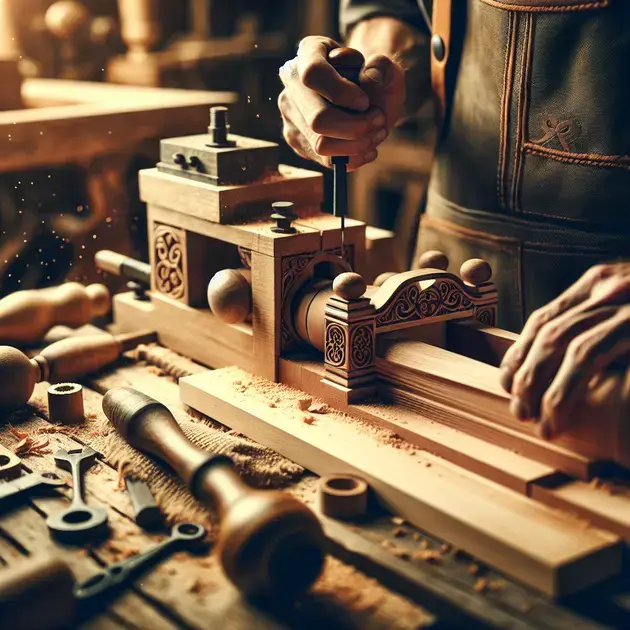When it comes to honing your crafting expertise, woodworking is a timeless skill that allows you to create functional and beautiful pieces from scratch. Whether you’re a seasoned woodworker or just starting out, mastering woodworking tips and tricks can take your projects to the next level.
From selecting the right type of wood to mastering different woodworking techniques, this guide will provide you with valuable insights and strategies to enhance your woodworking skills. With the right knowledge and practice, you can elevate your crafting expertise and turn your woodworking projects into works of art.

Enhancing Woodworking Skills Through Proper Wood Selection
Proper wood selection is crucial for any woodworking project, as different types of wood have unique characteristics that can impact the final outcome. One way to enhance your woodworking skills is by understanding the properties of various woods and selecting the most suitable one for your project. Websites like Wood Database provide detailed information on different wood species, including hardness, grain pattern, and color variations.
To begin, identify the specific requirements of your project, such as durability, aesthetics, or workability. For example, if you are working on a furniture piece that requires strength, you might opt for a hardwood like oak or maple. On the other hand, if you are aiming for intricate details, a softer wood like pine or cedar may be more appropriate.
After determining the wood characteristics needed, visit a local lumberyard or online retailer like Rockler to browse through their selection. Inspect the wood for any imperfections, such as knots or warping, that could affect your project. Consider purchasing extra wood to account for mistakes or unexpected changes during the woodworking process.
Once you have selected the perfect wood for your project, take the time to prepare it properly before starting. This may include planing, sanding, or applying a finish to enhance the natural beauty of the wood. By choosing the right wood and preparing it effectively, you can elevate your woodworking skills and create stunning pieces that stand the test of time.
Mastering Advanced Woodworking Techniques
Mastering advanced woodworking techniques requires dedication, practice, and a willingness to step out of your comfort zone. One way to enhance your skills is by exploring new methods and tools that can help you achieve more complex and intricate designs. Online platforms like Fine Woodworking offer tutorials and workshops on advanced techniques, such as dovetail joinery, marquetry, and turning.
Start by selecting a technique that interests you and familiarize yourself with the necessary tools and materials. For example, if you want to improve your carving skills, invest in high-quality chisels and carving knives. Practice on scrap wood before attempting the technique on your actual project to gain confidence and precision.
Seek guidance from experienced woodworkers either through online forums like WoodNet or in-person workshops at a local woodworking studio. Don’t be afraid to ask questions, seek feedback, and learn from your mistakes. Continuous learning and experimentation are key to mastering advanced techniques and taking your woodworking skills to the next level.
Remember, Rome wasn’t built in a day, and neither will your mastery of advanced woodworking techniques. Stay patient, persistent, and passionate about honing your craft, and soon you’ll be creating intricate masterpieces that showcase your expertise and dedication.
Unlocking the Secrets to Crafting Expertise
Becoming a master craftsman requires more than just technical skills; it also entails understanding the artistry and creativity behind woodworking. Unlocking the secrets to crafting expertise involves developing a keen eye for design, a deep appreciation for aesthetics, and a strong attention to detail. Websites like Woodcraft offer insights into the artistic aspects of woodworking through articles, videos, and design inspiration.
Start by studying various woodworking styles, from traditional to contemporary, and identifying elements that resonate with your personal taste. Experiment with different finishes, textures, and embellishments to add a unique touch to your projects. Incorporate design principles such as balance, proportion, and harmony to create visually appealing pieces that showcase your craftsmanship.
Expand your knowledge of woodworking history, cultural influences, and global trends to enrich your creative perspective. Attend woodworking exhibitions, join art communities like The Woodworkers Institute, and network with fellow craftsmen to gain fresh insights and inspiration. Embrace challenges, push boundaries, and dare to innovate in your woodworking projects to unlock the secrets to crafting expertise.
Remember, craftsmanship is not just about building things; it’s about imbuing soul, passion, and meaning into every piece you create. By embracing the artistry of woodworking and honing your creative skills, you can unlock the secrets to crafting expertise and leave a lasting legacy through your exceptional craftsmanship.

Sharpening Your Woodworking Tools for Precision
When it comes to woodworking, having sharp tools is essential for achieving precision in your projects. Blunt tools can lead to rough cuts, splintering, and inaccuracies in measurements. To ensure your woodworking tools are sharpened to perfection, follow these steps:
Step 1: Gather Your Sharpening Equipment
Before starting the sharpening process, make sure you have the necessary equipment. This may include sharpening stones, a honing guide, lubricating oil, and a leather strop.
Step 2: Understand the Sharpening Angle
Each woodworking tool has a specific sharpening angle that needs to be maintained. Research the recommended angle for your tools and use a honing guide to achieve consistent results.
Step 3: Start with Coarse Grit
Begin the sharpening process with a coarse grit sharpening stone to remove any nicks or damage on the tool’s edge. Move the tool back and forth across the stone until the edge is evenly sharpened.
Step 4: Progress to Fine Grit
Once the tool edge is refined with the coarse grit, switch to a finer grit stone to further sharpen and hone the edge. Repeat the sharpening motion until the tool is razor-sharp.
Step 5: Strop for the Perfect Edge
Finish the sharpening process by stropping the tool on a leather strop. This will polish the edge and remove any remaining burrs, leaving you with a finely sharpened woodworking tool ready for precision work.
Exploring Innovative Woodworking Materials
Woodworking has evolved over the years, and now there are various innovative materials available to enhance your projects. By incorporating these materials, you can create unique and durable woodworking pieces. Here are some steps to explore innovative woodworking materials:
Step 1: Research New Materials
Start by researching new and innovative woodworking materials on the market. Look for materials that offer different aesthetics, strengths, or environmental benefits compared to traditional wood.
Step 2: Experiment with Composite Materials
Composite materials, such as wood-plastic composites or engineered wood, offer a blend of wood fibers and synthetic components for increased durability and design flexibility. Experiment with these materials in your projects.
Step 3: Consider Sustainable Options
With a growing focus on sustainability, explore woodworking materials made from recycled or eco-friendly sources. These materials not only reduce your environmental impact but also add a unique element to your projects.
Step 4: Embrace High-Tech Materials
Technological advancements have introduced high-tech woodworking materials like carbon fiber or glass-reinforced plastics. These materials provide exceptional strength and lightweight properties for innovative woodworking designs.
Step 5: Blend Traditional and Modern Materials
For a truly unique woodworking experience, consider blending traditional wood with modern innovative materials. This combination can result in one-of-a-kind pieces that showcase the best of both worlds.
Achieving Mastery in Woodworking Projects
Mastering woodworking requires dedication, practice, and a continuous quest for improvement. Whether you are a beginner or an experienced woodworker, aiming for mastery in your projects can elevate your skills to the next level. Follow these steps to achieve woodworking mastery:
Step 1: Set Clear Goals
Define your woodworking goals and aspirations. Whether it’s mastering a specific technique, building intricate furniture, or creating artful designs, having clear goals will guide your woodworking journey.
Step 2: Invest in Quality Tools
Quality tools are essential for achieving precision and efficiency in woodworking. Invest in high-quality hand tools, power tools, and measuring equipment to support your mastery journey.
Step 3: Practice Regularly
Practice is key to improving your woodworking skills. Set aside dedicated time each week to work on projects, experiment with techniques, and refine your craftsmanship.
Step 4: Seek Mentorship and Education
Learning from experienced woodworkers and taking woodworking courses can provide valuable insights and techniques to enhance your skills. Don’t hesitate to seek mentorship and education to accelerate your mastery journey.
Step 5: Embrace Challenges and Learn from Mistakes
Woodworking mastery is a journey filled with challenges and learning opportunities. Embrace mistakes as learning experiences, and use them to refine your techniques and approach towards woodworking projects.
**
Conclusion
**
Mastering woodworking goes beyond just creating projects; it involves dedication and continuous improvement. By setting clear goals, investing in quality tools, practicing regularly, seeking mentorship, and embracing challenges, you can elevate your woodworking skills to new heights.
Sharpening Your Tools
When it comes to woodworking precision, sharp tools are crucial. Following the steps of gathering the right equipment, understanding sharpening angles, starting with coarse grit, progressing to fine grit, and using a strop for the perfect edge ensures your tools are finely tuned for precise work.
Exploring Innovative Materials
Woodworking has evolved with the introduction of innovative materials. Researching new materials, experimenting with composites, considering sustainable options, embracing high-tech materials, and blending traditional with modern materials can result in unique and durable woodworking pieces that showcase creativity and craftsmanship.
Achieving Mastery
To achieve woodworking mastery, dedication and practice are key. By defining clear goals, investing in quality tools, practicing regularly, seeking mentorship and education, and learning from mistakes, woodworkers at any level can advance their skills and create exceptional projects that reflect their passion for woodworking.